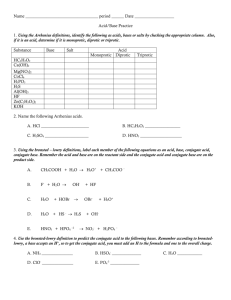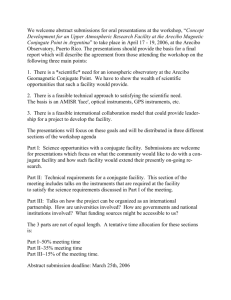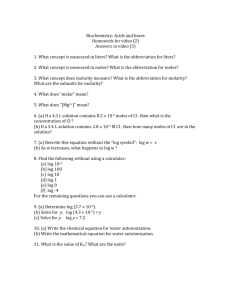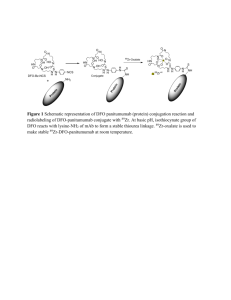Tutorial 14 - Solutions
advertisement
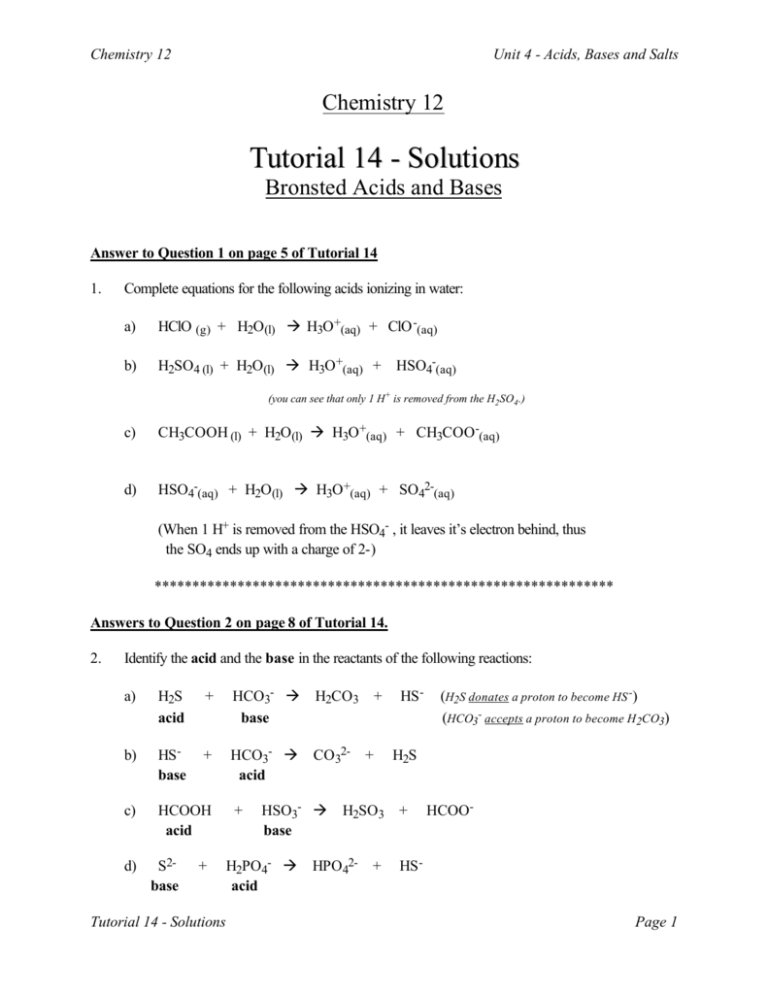
Chemistry 12 Unit 4 - Acids, Bases and Salts Chemistry 12 Tutorial 14 - Solutions Bronsted Acids and Bases Answer to Question 1 on page 5 of Tutorial 14 1. Complete equations for the following acids ionizing in water: a) HClO (g) + H2O(l) à H3O+(aq) + ClO -(aq) b) H2SO4 (l) + H2O(l) à H3O+(aq) + HSO4-(aq) (you can see that only 1 H+ is removed from the H2 SO4 .) c) CH3COOH (l) + H2O(l) à H3O+(aq) + CH3COO-(aq) d) HSO4-(aq) + H2O(l) à H3O+(aq) + SO42-(aq) (When 1 H+ is removed from the HSO4- , it leaves it’s electron behind, thus the SO4 ends up with a charge of 2-) ************************************************************* Answers to Question 2 on page 8 of Tutorial 14. 2. Identify the acid and the base in the reactants of the following reactions: a) H2S acid + HCO3- à base H2CO3 + b) HSbase + HCO3- à acid CO32- + c) HCOOH acid d) S2base + Tutorial 14 - Solutions + HSO3- à base H2PO4- à acid HS - H2S H2SO3 + HPO42- + (H2S donates a proton to become HS -) (HCO3- accepts a proton to become H2CO3) HCOO- HS - Page 1 Chemistry 12 e) H2SO3 acid f) NH4+ acid Unit 4 - Acids, Bases and Salts HCO3- à base + H2O à base + H2CO3 + H3O+ + HSO3- NH3 ************************************************************* Answer to Question 3 on page 9 of Tutorial 14 3. Identify acids and bases on the left side and the right side of the following equations: Hint: To get the ones on the right, pretend the reaction is going in reverse. a) H3BO3 acid b) NO2- + base c) C6H5OH acid + NH3 base HIO 3 acid + OHbase H2BO3- + NH4+ base acid HNO2 + IO 3acid base C6H5O- + base H2O acid ************************************************************** Answers to Question 4 on pages 10 of Tutorial 14 4. Identify the conjugate acid-base pairs in each of the following reactions: (NOTE: “Pair 1” and “Pair 2” could be exchanged and the answer would still be correct.) a) NH3 + CH3COOH Pair 1: (acid) CH3 COOH Pair 2: (acid) NH4 + b) H2SO3 + H2PO4- Pair 1: (acid) H2 SO3 Pair 2: (acid) H3 PO4 Tutorial 14 - Solutions NH4+ + CH3COO- (base) CH3 COO(base) NH3 H3PO4 + HSO3(base) HSO3 (base) H2 PO4 - Page 2 Chemistry 12 c) HC2O4- + Unit 4 - Acids, Bases and Salts HNO2 Pair 1: (acid) HNO2 Pair 2: (acid) H2 C2 O4 d) Al(H2O)63+ + HCO3- NO2- + H2C2O4 (base) NO2 (base) HC2 O4 Al(H2O)5(OH)2+ + H2CO3 Pair 1: (acid) Al(H2 O)6 3+ (base) Al(H2 O)5 (OH)2+ Pair 2: (acid) H2 CO3 (base) HCO3 *************************************************************** Answers to Question 5 on Page 11 of Tutorial 14 5. Find the conjugate acid of each of the following. Make sure you have the charges correct: a) CH3COO- conjugate acid is ........................ __________ CH3 COOH ___ b) SO42- conjugate acid is ........................ ____________ HSO4 - _____ c) H2O conjugate acid is ........................ __________ H3 O+ _______ d) O2- conjugate acid is ........................ __________ OH- _________ e) OH- conjugate acid is ........................ ___________ H2 O ________ f) HPO42- conjugate acid is ........................ g) H2PO4- conjugate acid is ........................ _________ H3 PO4 ________ h) NH3 conjugate acid is ........................ __________ NH4 + ________ H2 PO4 - (Make sure you have the charge correct.) *************************************************************** Answers to Question 6 on page 12 of Tutorial 14. 6. Find the conjugate base of each of the following. Make sure you have the charges correct: a) HNO3 conjugate base is ........................ ___________ NO3 - _______ b) H2C2O4 conjugate base is ........................ _________ HC2 O4 - ______ Tutorial 14 - Solutions Page 3 Chemistry 12 Unit 4 - Acids, Bases and Salts c) H2SO3 conjugate base is ........................ __________ HSO3 - _______ d) HNO2 conjugate base is ........................ __________ NO2 - ________ e) HClO 3 conjugate base is ........................ _________ ClO3 - _________ f) H2O conjugate base is ........................ ___________ OH- _________ g) OH- conjugate base is ........................ __________ O2- __________ h) NH4+ conjugate base is ........................ __________ NH3 ________ ************************************************************** Answer to Question 7 on page 15 of Tutorial 14. 7. a) Write the three equations showing the stepwise dissociation of arsenic acid H3AsO 4. Step 1: H3 AsO4(aq) + H2 O(l) H3 O+(aq) + H2 AsO4 -(aq) Step 2: H2 AsO4 -(aq) + H2 O(l) H3 O+(aq) + HAsO4 2-(aq) Step 3: HAsO4 2-(aq) H3 O+(aq) + AsO4 3-(aq) + H2 O(l) b) Summarize this process by leaving out the H3O+’s and H2O’s like was done for phosphoric acid in the example right above this question. See if you can come up with names for all the ions! H3 AsO4 step 1 à arsenic acid Tutorial 14 - Solutions H2 AsO4 - dihydrogen arsenate step 2 à HAsO4 2- monohydrogen arsenate step 3 à AsO4 3arsenate Page 4 Chemistry 12 Unit 4 - Acids, Bases and Salts Answer to Question 8 on page 17 of Tutorial 14. 8. a) Write the two steps in the dissociation of carbonic acid (H2CO3). Step 1: H2 CO3(aq) + H2 O(l) H3 O+(aq) + HCO3 -(aq) Step 2: HCO3 -(aq) + H2 O(l) H3 O+(aq) + CO3 2-(aq) b) Give the formula and the name for the amphiprotic anion formed in this process. Formula HCO3 Name (you may use the acid chart.) hydrogen carbonate or bicarbonate ************************************************************ Answers to the Self-Test starting on page 17 of Tutorial 14 H3 O+ 1. What is meant by a hydronium ion? 2. How does a hydronium ion form in water? An H+ ion attaches itself to a water molecule 3. A hydronium ion can also be called a hydrated proton. 4. Complete the equations for the ionization of the following acids in water: 5. a) HClO2(aq) + H2 O(l) b) HF(g) + H2 O(l) c) HNO2(aq) + H2 O(l) d) HCOOH(l) + H2 O(l) H3 O+(aq) H3 O+(aq) + H3 O+(aq) H3 O+(aq) + ClO2 -(aq) F-(aq) + + NO2 -(aq) HCOO-(aq) Give the Arrhenius definitions of the following: a) an acid - a substance that releases H+ ions (protons) in water. b) a base - a substance that releases OH- (hydroxide) ions in water. Tutorial 14 - Solutions Page 5 Chemistry 12 6. 7. 8. Unit 4 - Acids, Bases and Salts Give the Bronsted definitions of the following: a) an acid - any substance which donates (gives) a proton (H+) to another substance b) a base - any substance which accepts (takes) a proton (H+) from another substance Identify acids and bases on the left side and the right side of the following equations: a) C6H5OH acid + b) H2PO4- + base CO32base H2SO3 acid HCO3- + acid C6H5Obase H3PO4 acid HSO3 base + Identify the conjugate acid-base pairs in each of the following reactions: a) NH3 + H2SO3 Pair 1: (acid) H2 SO3 Pair 2: (acid) NH4 + NH4+ + HSO3(base) HSO3 (base) NH3 NOTE: It would still be correct if you had pair 1 and pair 2 exchanged. b) H2C2O4 + H2PO4- Pair 1: (acid) H2 C2 O4 Pair 2: (acid) H3 PO4 H3PO4 + HC 2O4 (base) HC2 O4 (base) H2 PO4 - NOTE: It would still be correct if you had pair 1 and pair 2 exchanged. c) HC2O4- + CH3COOH CH3COO- + H2C2O4 Pair 1: (acid) CH3 COOH (base) CH3 COOPair 2: (acid) H2 C2 O4 (base) HC2 O4 NOTE: It would still be correct if you had pair 1 and pair 2 exchanged. Tutorial 14 - Solutions Page 6 Chemistry 12 9. 10. 11. Unit 4 - Acids, Bases and Salts Find the conjugate acid of each of the following. Make sure you have the charges correct: a) HCOO- conjugate acid is ........................ __________ HCOOH ____ b) PO43- conjugate acid is ........................ ___________ HPO4 2- ____ c) OH- conjugate acid is ........................ ____________ H2 O _____ d) H2BO3- conjugate acid is ........................ ____________ H3 BO3 ___ e) H2O conjugate acid is ........................ ___________ H3 O+ _____ Find the conjugate base of each of the following. Make sure you have the charges correct: a) H2CO3 conjugate base is ........................ _________ HCO3 - ______ b) HC2O4- conjugate base is ........................ _________ C2 O4 2- ______ c) HSO3- conjugate base is ........................ _________ SO3 2- _______ d) HNO2 conjugate base is ........................ _________ NO2 - ________ e) H2PO4- conjugate base is ........................ ________ HPO4 2- ______ a) Write the three equations showing the stepwise dissociation of boric acid (H3BO3). Step 1: H3 BO3(aq) + H2 O(l) H3 O+(aq) + H2 BO3 -(aq) Step 2: H2 BO3 -(aq) + H2 O(l) H3 O+(aq) + HBO3 2-(aq) Step 3: HBO3 2-(aq) + H2 O(l) H3 O+(aq) + BO3 3-(aq) b) Give the formulas and the names for the amphiprotic anions formed in this process. Formula H2 BO3 - Name dihydrogen borate Formula HBO3 2- Name monohydrogen borate Tutorial 14 - Solutions Page 7 Chemistry 12 Unit 4 - Acids, Bases and Salts 12. If the ion HPO32- was to act an acid, it would form PO3 3- 13. If the ion HPO32- was to act a base, it would form 14. How can you recognize an amphiprotic anion? It has at least one “H” and it has a negative charge H2 PO3 - This is the end of Tutorial 14 - Solutions ********************************************************** Tutorial 14 - Solutions Page 8



